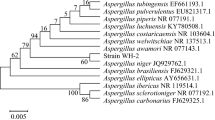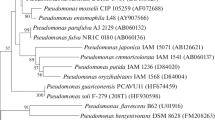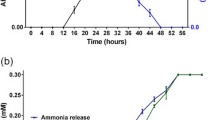Abstract
A bacterium that assimilates (S)-3-chloro-1,2-propanediol [monochlorohydrin (MCH)] was isolated from soil by enrichment culture. The bacterium was identified as Pseudomonas sp. by taxonomic studies. The strain grew in a medium containing racemic MCH as a source of carbon and degraded (S)-MCH stereoselectively, liberating chloride ions. The residual isomer was the (R)-form [99.5% enantiomeric excess (ee)], which was obtained from the racemate in a final yield of 36% by using this strain. Subsequently, highly optically active (R)-glycidol (GLD) (99.3% ee) was prepared from the (R)-MCH obtained by reaction in alkaline solution. The cell-free extracts of the cells had both dehalogenating and epoxide-opening activities, which converted various halohydrins to the corresponding epoxides and epoxides to the corresponding diols, respectively.
Similar content being viewed by others
References
Baldwin JJ, Raab AW, Mensler K, Arison BH, McClure DE (1978) Synthesis of (R)- and (S)-epichlorohydrin. J Org Chem 43:4876–4878
Brinley-Morgan WJ, Ley DJ, Dye DW, Larsen H, Vincent JM, Whittenbury R (1984) Gram-negative aerobic rods and cocci. In: Krieg NR (ed) Bergey's manual of systematic bacteriology, vol 1, 9th edn. Williams & Wilkins, Baltimore, pp 140–407
Burgos CE, Ayer DE, Johnson RA (1987) A new, asymmetric synthesis of lipids and phospholipids. J Org Chem 52:4973–4977
Dougherty W, Liotta F, Mondimore D, Shum W (1990) A convenient gas chromatographic method for the optical purity determination of chiral epoxy alcohols. Tetrahedron Lett 31:4389–4390
Fourneau E, Marquès IRY (1926) Sur la préparation de l'α-monochlorohydrine de la glycérine. Bull Soc Chim 39:699–700
Gao Y, Klunder JM, Hanson RM, Masamune H, Ko SY, Sharpless KB (1987) Catalytic asymmetric epoxidation and kinetic resolution: modified procedures including in situ derivatization. J Am Chem Soc 109:5765–5780
Hamaguchi S, Ohashi T, Watanabe K (1986) Lipase-catalyzed stereoselective hydrolysis of 2-acyloxy-3-chloropropyl p-tolu-enesulfonate. Agric Biol Chem 50:375–380
Haouet A, Sepulchre M, Spassky N (1983) Preparation and properties of poly[(R)-glycidols]. Eur Polym J 19:1089–1098
Iriuchijima S, Kojima N (1982) Asymmetric hydrolysis of (±)-1,2-diacetoxy-3-chloropropane and its related compounds with lipase. Synthesis of optically pure (S)-propanolol. Agric Biol Chem 46:1153–1157
Iwasaki I, Utsumi S, Ozawa T (1952) New colorimetric determination of chloride using mercuric thiocyanate and ferric ion. Bull Chem Soc Jpn 25:26
Jones HF (1978) Stereospecific synthesis of R- and S-3-chloropropan-1,2-diol. Chem Ind 15:533
Kasai N, Tsujimura K, Unoura K, Suzuki T (1990) Degradation of 2,3-dichloro-1-propanol by a Pseudomonas sp. Agric Biol Chem 54:3158–3190
Kasai N, Tsujimura K, Unoura K, Suzuki T (1992a) Preparation of (S)-2,3-dichloro-1-propanol by Pseudomonas sp. and its use in the synthesis of (R)-epichlorohydrin. J Ind Microbiol 9:97–101
Kasai N, Tsujimura K, Unoura K, Suzuki T (1992b) Isolation of (S)-2,3-dichloro-1-propanol assimilating bacterium, its characterization, and its use in preparation of (R)-2,3-dichloro-1-propanol and (S)-epichlorohydrin. J Ind Microbiol 10:37–43
Kleemann A, Wagner R (1981a) Chemical properties of glycidol. In: Kleemann A, Wagner R (eds) Glycidol. Hünthig, Heidelberg, pp 52–58
Kleemann A, Wagner R (1981b) Preparation of glycidol. In: Kleemann A, Wagner R (eds) Glycidol. Hünthig, Heidelberg, pp 33–36
Klunder JM, Ko SY, Sharpless KB (1986) Asymmetric epoxidation of allyl alcohol: efficient routes to homochiral \-adrenergic blocking agents. J Org Chem 51:3710–3712
Komagata K (1981) Classification and identification of aerobic bacteria. In: Hasegawa T (ed) Classification and identification of microorganisms. Gakkai syuppan Center, Tokyo, pp 203–245
Ladner WE, Whitesides GM (1984) Lipase-catalyzed hydrolysis as a route to esters of chiral epoxy alcohols. J Am Chem Soc 106:7250–7251
Lee LG, Whitesides GM (1986) Preparation of optically active 1,2-diols and α-hydroxy ketones using glycerol dehydrogenase as catalyst: limits to enzyme-catalyzed synthesis due to non-competitive and mixed inhibition by product. J Org Chem 51:25–36
Lok CM, Ward JP, Vandorp DA (1976) The synthesis of chiral glycerides starting from d- and l-serine. Chem Phys Lipids 16:115–122
Lowry OH, Rosebrough NJ, Farr AL, Randall RJ (1951) Protein measurement with the Folin phenol reagent. J Biol Chem 193:256–275
Markonikoff W (1870) I. Ueber die Abhängigkeit der verschiedenen Vertretbarkeit des Radicalwasserstoffs in den isomeren Buttersäuren. Liebigs Ann Chem 153:228–259
Nakamura T, Yu F, Mizunashi W, Watanabe I (1991) Microbial transformation of prochiral 1,3-dichloro-2-propanol into optically active 3-chloro-1,2-propanediol. Agric Biol Chem 55:1931–1933
Porter KE, Jones AR (1982) The effect of the isomer of α-chlorohydrin and racemic \-chlorolactate on the rat kidney. Chem-Biol Interact 41:95–104
Rider TH, Hill AJ (1930) Studies of glycidol. I. Preparation from glycerol monochlorohydrin. J Am Chem Soc 52:1521–1527
Sowden JC, Fischer OL (1942) l-Glycidol. J Am Chem Soc 64:1291–1293
Suzuki T, Kasai N, Yanamoto R, Minamiura N (1992) Isolation of a bacterium assimilating (R)-3-chloro-1,2-propanediol and production of (S)-3-chloro-1,2-propanediol using microbial resolution. J Ferment Bioeng 73:443–448
Takahashi H, Tsuda S, Nakamura Y, Ogura M, Shiraishi T, Shimada Y (1989) Production of (R)-3-chloro-1,2-propanediol by microorganisms. In: Yamada H (ed) Abstracts of papers, the Annual Meeting of Agricultural and Chemical Society of Japan, Gakkaishi kanko Center, Tokyo, pp 351
Wijngaard AE van den, Janssen DB, Witholt B (1989) Dehalogenation of epichlorohydrin and halohydrins by bacterial cultures isolated from freshwater sediment. J Gen Microbiol 135:2199–2208
Author information
Authors and Affiliations
Additional information
Correspondence to: T. Suzuki
Rights and permissions
About this article
Cite this article
Suzuki, T., Kasai, N., Yamamoto, R. et al. Production of highly optically active (R)-3-chloro-1,2-propanediol using a bacterium assimilating the (S)-isomer. Appl Microbiol Biotechnol 40, 273–278 (1993). https://doi.org/10.1007/BF00170380
Received:
Accepted:
Issue Date:
DOI: https://doi.org/10.1007/BF00170380




